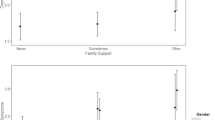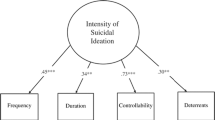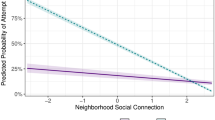Abstract
Suicide is the leading cause of death among youth experiencing homelessness, and these youth report high rates of suicide attempts. Research suggests that the interpersonal factors of perceived burdensomeness and thwarted belongingness are proximal causes of suicide, but little is known about factors associated with these risks. The current study examined the relationship of social network characteristics, perceived social network support, and interpersonal risks for suicide among a sample of 150 youth experiencing homelessness who reported severe suicide ideation. Findings indicate that characteristics of the social network, including engagement in crime and alcohol use, interrupted the potentially protective effects of high perceived social network support for interpersonal risk factors of suicide. Findings imply that increasing perceived social network support as a protection against suicide will not be uniformly successful, and consideration of the social network characteristics is necessary. Future work needs to continue to uncover the complexity of modifiable intervention targets to prevent future suicide attempts among this high-risk group.


Similar content being viewed by others
References
Bao, W., Whitbeck, L. B., & Hoyt, D. R. (2000). Abuse, support, and depression among homeless and runaway adolescents. Journal of Health and Social Behavior, 41(4), 408–420.
Bates, D. S., & Toro, P. A. (1999). Developing measures to assess social support among homeless and poor people. Journal of Community Psychology, 27(2), 137–156.
Beck, A. T., & Steer, R. A. (1988). Beck hopelessness scale. San Antonio, TX: The Psychological Corporation.
Beck, A. T., Brown, G. K., Steer, R. A., Dahlsgaard, K. K., & Grisham, J. R. (1999). Suicide ideation at its worst point: A predictor of eventual suicide in psychiatric outpatients. Suicide and Life-Threatening Behavior, 29(1), 1–9.
Brown, G. K., Beck, A. T., Steer, R. A., & Grisham, J. R. (2000). Risk factors for suicide in psychiatric outpatients: a 20-year prospective study. Journal of Consulting and Clinical Psychology, 68(3), 371.
Centers for Disease Control and Prevention. (2012). Youth risk behavior surveillance—United States 2011 Morbidity and Mortality Weekly Report. Surveillance Summaries, 61(4), 10–12.
Centers for Disease Control and Prevention (CDC). (2013). Web-based injury statistics query and reporting system (WISQARS). Retrieved from: https://www.cdc.gov/injury/wisqars/index.html.
Cleverley, K., & Kidd, S. A. (2011). Resilience and suicidality among homeless youth. Journal of Adolescence, 34(5), 1049–1054.
Cohen, J. (1988). Statistical power analysis for the behavioral sciences (2nd ed.). Hillsdale, NJ: Erlbaum.
Conwell, Y. (2001). Suicide in later life: A review and recommendations for prevention. Suicide and Life-Threatening Behavior, 31(Supplement to Issue 1), 32–47.
Dang, M. T. (2014). Social connectedness and self-esteem: Predictors of resilience in mental health among maltreated homeless youth. Issues in Mental Health Nursing, 35(3), 212–219.
Faul, F., Erdfelder, E., Buchner, A., & Lang, A.-G. (2009). Statistical power analyses using G*Power 3.1: Tests for correlation and regression analyses. Behavior Research Methods, 41, 1149–1160.
First, M. B., Williams, J. B. W., Karg, R. S., & Spitzer, R. L. (2015). User’s guide for the structured clinical interview for DSM-5 disorders: Research version. Arlington, VA: American Psychological Association.
Frederick, T. J., Kirst, M., & Erickson, P. G. (2012). Suicide attempts and suicidal ideation among street-involved youth in Toronto. Advances in Mental Health, 11(1), 8–17.
Hadland, S. E., Wood, E., Dong, H., Marshall, B. D. L., Kerr, T., Montaner, J. S., et al. (2015). Suicide attempts and childhood maltreatment among street youth: A prospective cohort study. Pediatrics, 136(3), 440–449.
Hirsch, J. K., & Barton, A. L. (2011). Positive social support, negative social exchanges, and suicidal behavior in college students. Journal of American College Health, 59(5), 393–398.
Jahn, D. R., & Cukrowicz, K. C. (2011). The impact of the nature of relationships on perceived burdensomeness and suicide ideation in a community sample of older adults. Suicide and Life-Threatening Behavior, 41(6), 635–649.
Joiner, T. E., Van Orden, K. A., Witte, T. K., Selby, E. A., Ribeiro, J. D., Lewis, R., et al. (2009). Main predictions of the interpersonal–psychological theory of suicidal behavior: Empirical tests in two samples of young adults. Journal of Abnormal Psychology, 118(3), 634–646.
Katz, C., Bolton, S., Katz, L. Y., Isaak, C., Tilston-Jones, T., Sareen, J., et al. (2013). A systematic review of school-based suicide prevention programs. Depression and Anxiety, 30, 1030–1045.
Kidd, S. A. (2006). Factors precipitating suicidality among homeless youth: A quantitative follow-up. Youth & Society, 37(4), 393–422.
Kidd, S. A., & Carroll, M. R. (2007). Coping and suicidality among homeless youth. Journal of Adolescence, 30(2), 283–296.
Kingree, J. B., Braithwaite, R., & Woodring, T. (2001). Psychosocial and behavioral problems in relation to recent experience as a runaway among adolescent detainees. Criminal Justice and Behavior, 28(2), 190–205.
Marshall, B. D. L., Galea, S., Wood, E., & Kerr, T. (2013). Longitudinal associations between types of childhood trauma and suicidal behavior among substance users: A cohort study. American Journal of Public Health, 103(9), e69–e75.
Merscham, C., Van Leeuwen, J. M., & McGuire, M. (2009). Mental health and substance abuse indicators among homeless youth in Denver. Colorado. Child Welfare, 88(2), 93–110.
Miller, D. N., Eckert, T. L., & Mazza, J. J. (2009). Suicide prevention programs in the schools: A review and public health perspective. School Psychology Review, 38(2), 168–188.
National Institute on Alcohol Abuse and Alcoholism (NIAAA) (2020). Alcohol facts and statistics. Retrieved from https://www.niaaa.nih.gov/publications/brochures-and-fact-sheets/alcohol-facts-and-statistics.
Rew, L., Taylor-Seehafer, M., & Fitzgerald, M. L. (2001). Sexual abuse, alcohol and other drug use, and suicidal behaviors in homeless adolescents. Issues in Comprehensive Pediatric Nursing, 24(4), 225–240.
Rice, E., Kurzban, S., & Ray, D. (2012). Homeless but connected: The role of heterogeneous social ties and social network technology in the mental health outcomes of street-living adolescents. Community Mental Health Journal, 48(6), 692–698.
Rotheram-Borus, J., & Milburn, N. (2004). Project I: Pathways into homelessness. Los Angeles, CA: UCLA Center for Community Health.
Toro, P. A., Goldstein, M. S., Rowland, L. L., Bellavia, C. W., Wolfe, S. M., Thomas, D. M., et al. (1999). Severe mental illness among homeless adults and its association with longitudinal outcomes. Behavior Therapy, 30, 431–452.
Van Orden, K. A., Witte, T. K., Cukrowicz, K. C., Braithwaite, S. R., Selby, E. A., & Joiner, T. E. (2010). The interpersonal theory of suicide. Psychological review, 117(2), 575–600.
Van Orden, K. A., Cukrowicz, K. C., Witte, T. K., & Joiner, T. E., Jr. (2012). Thwarted belongingness and perceived burdensomeness: Construct validity and psychometric properties of the Interpersonal Needs Questionnaire. Psychological Assessment, 24(1), 197–215.
Wilson, S. R., Lubman, D. I., Rodda, S., Manning, V., & Yap, M. B. H. (2018). The impact of problematic substance use on partners’ interpersonal relationships: Qualitative analysis of counselling transcripts from a national online service. Drugs: Education, Prevention, and Policy. https://doi.org/10.1080/09687637.2018.1472217.
Yoder, K. A., Whitbeck, L. B., & Hoyt, D. R. (2003). Gang involvement and membership among homeless and runaway youth. Youth & Society, 34(4), 441–467.
Yoder, K. A., Whitbeck, L. B., & Hoyt, D. R. (2010). Comparing subgroups of suicidal homeless adolescents: Multiple attempters, single attempters, and ideators. Vulnerable Children and Youth Studies, 5(2), 151–162.
You, S., Van Orden, K. A., & Conner, K. R. (2011). Social connections and suicidal thoughts and behavior. Psychology of Addictive Behaviors, 25(1), 180–184.
Acknowledgements
This work was supported by NIDA Grant No. R34DA037845 to the first author.
Author information
Authors and Affiliations
Corresponding author
Ethics declarations
Conflict of interest
The authors declare that they have no conflict of interest. The authors certify responsibility for the for the conduct of the study and the analysis and interpretation of the data, helped write the manuscript and agree with the decisions about it, meet the definition of an author as stated by the International Committee of Medical Journal Editors, and have seen and approved the final manuscript.
Ethical Approval
All procedures performed in studies involving human participants were in accordance with the ethical standards of the institutional and/or national research committee and with the 1964 Helsinki declaration and its later amendments or comparable ethical standards.
Informed Consent
Informed consent was obtained from all individual participants included in the study.
Additional information
Publisher's Note
Springer Nature remains neutral with regard to jurisdictional claims in published maps and institutional affiliations.
Rights and permissions
About this article
Cite this article
Slesnick, N., Zhang, J. & Walsh, L. Youth Experiencing Homelessness with Suicidal Ideation: Understanding Risk Associated with Peer and Family Social Networks. Community Ment Health J 57, 128–135 (2021). https://doi.org/10.1007/s10597-020-00622-7
Received:
Accepted:
Published:
Issue Date:
DOI: https://doi.org/10.1007/s10597-020-00622-7




